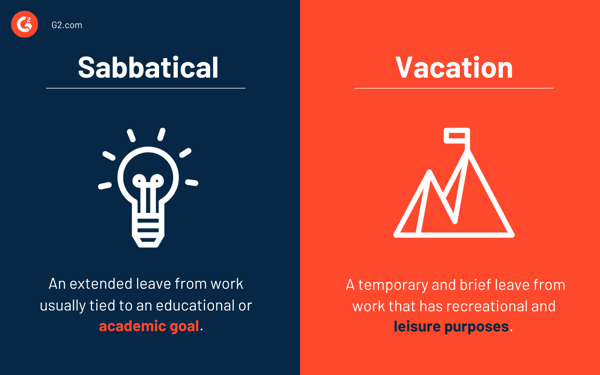
Day in and day out, your employees show up, work hard, and take the necessary steps to ensure the company hits its goals.
Outside of regular company perks, how do you say thank you to the employees who have been at the company for years and have spent countless hours striving for excellence? If you’re looking for a new way to give your employees a break and reward them for their years of service, you may want to consider giving them the opportunity to take a sabbatical.
A sabbatical is a period of leave where an employee doesn’t report to their job but is still employed by the organization. It’s typically taken when an employee has worked for a company for a specific amount of time, usually five years, and can be spent studying, traveling, learning new skills, or volunteering.
Originally sabbaticals were more commonly used in the educational field when a professor at a college or university was given time off to take a semester or two of leave to further their education, teach at a university abroad, write, or conduct original research.
However, it’s becoming more common for companies outside of higher ed to offer their full-time employees a sabbatical. Depending on the company or the nature of work, a sabbatical may be paid or unpaid, but it always guarantees a return to work at the end of the leave.
Did you know? The word “sabbatical” is derived from the biblical term “Sabbath,” meaning a day of rest or the seventh day.
Sabbaticals, like other types of leave, can be tracked by managers and HR professionals using absence management software. These tools make it easier for organizations to manage and plan for when employees will be absent from their role, how to keep track of requests and approvals, and allows for all policies to be organized in one place.
The terms “sabbatical” and “vacation” are sometimes used interchangeably when referring to paid time off, but they’re different. While they both indicate time off that employees take to avoid burnout, it’s important to understand how they differ.
A sabbatical is usually longer than a vacation. While on average, corporate organizations within America offer two weeks of vacation per year, a paid sabbatical can be anywhere from four to eight weeks.
In academia, the period of time can be as long as a full year, and a university may also choose to require a member of their faculty to submit an official sabbatical request that details what they’re hoping to accomplish for their professional development.
Unlike vacation time, a sabbatical can sometimes be tied to a goal that enhances work in some way. For example, a professor may choose to go on sabbatical to research or write a book or teach a similar subject at a foreign university. On the other hand, a sales representative may choose to take vacation time to spend a long weekend in California with their family.

The length of a sabbatical offered to employees will depend on specifics decided within an organization. It can also depend on how long an employee has worked with a company. At some universities, sabbaticals can last six months, a year (referred to as a “sabbatical year”), or more.
At private or publicly owned organizations, a sabbatical can be one or more months, depending on how many years of service an employee has under their belt.
As an example, let’s take a look at what Adobe offers its employees. When an employee reaches five years at Adobe, employees are offered a four-week-long sabbatical, equalling 20 business days. For employees who reach 10 years, they are offered five weeks, or 25 business days. For 15 years, employees are offered six weeks, or 30 business days. For every five years after that, employees are offered six weeks, equalling 30 business days.
The sabbatical leave policy is usually written or drawn up by an organization’s human resources department. It’s crucial that the rules of the sabbatical policy are abundantly clear to avoid confusion. Here are some questions your sabbatical leave policy should answer:
Who qualifies for sabbatical leave?
Clearly define when an employee becomes eligible for sabbatical leave. It’s common to offer this after five years, but whatever your company goes with, make sure to be specific.
How early should employees request sabbatical leave?
Employees should give your company ample time and notice that they’ll be taking a sabbatical. Define how much time before their sabbatical leave begins that they need to fill out a leave form. If the length of time is four weeks, the policy can request an employee give double the length of time in notice, meaning eight weeks notice. Also note who approves sabbatical requests for each department.
How long does a sabbatical last?
Like the Adobe example above, be sure to specify how long a sabbatical can last and whether or not it depends on how long an employee has been working for the company. The policy should also state if there’s a maximum amount of time that an employee can go on sabbatical leave.
Is sabbatical leave paid or unpaid?
Be sure to specify if the sabbatical will be paid or unpaid. This can depend on an organization’s budget and the length of time a sabbatical will last. If it’s not going to be fully paid, some companies decide to pay a certain percentage of the employee’s salary while they take sabbatical leave.
It may seem that the benefits of offering a sabbatical to your employees only benefit the employees. But in reality, there are many advantages that companies can see when incorporating this policy into its benefits administration.
For starters, offering employees the option to take a sabbatical is a great way to reduce burnout. No matter the industry or the size of your company, at some point, employees are going to need a break. When they’re able to take a sabbatical, it gives them a chance to recharge, rest, and come back to work feeling refreshed.
of employed Americans report they are currently experiencing worker burnout.
Source: Spring Health
Since many sabbaticals come with the notion that the individual will be doing research to advance their career, a clear benefit is that sabbaticals come with the potential for new professional discoveries, a boost in career insights, and new inspiration toward their profession.
Additionally, sabbaticals tend to boost employee retention. Since they’re typically only offered after five years or more of full-time work at an organization, this gives workers the incentive to stick around so that they can take advantage of this benefit.
Once the sabbatical policy is in place, make sure that it’s used to recruit talent when implemented into all of your company’s recruitment marketing strategies. Recruiters for your company can be sure that interested candidates know your organization is invested in them for the long term by rewarding them with a sabbatical after a certain amount of time. Having this in place could be what sways a candidate to join your team instead of the competition.
Finally, companies that offer employee sabbaticals can also see improved productivity rates across departments. Because your long-term employees don’t feel burnout and are encouraged to take this time away from work, they can come back to their job feeling more productive than ever.
In addition to the Adobe example above, let’s take a look at eight more examples of what other companies offer their employees in terms of sabbatical for an extended break away from work.
Employees at HubSpot are offered a four-week paid sabbatical, plus $5,000 spending money after they’ve worked at the organization for five years. Their website even elaborates on how their employees have used a sabbatical by saying, “Some employees take vacations with their families, while others learn how to play the guitar or enjoy month-long honeymoons.”
At Salesforce, employees can use one week of an unpaid sabbatical for every year of full-time employment within the organization. Employees can utilize this time, in addition to a long list of company holidays, volunteer time off, and flexible time off.
Autodesk gives employees a six-week paid sabbatical for every four continuous years of full-time employment. They go into detail to explain that this time “is an opportunity to travel or spend quality time with your family and friends while getting well-deserved rest and relaxation.”
Outdoor clothing company Patagonia offers a different kind of sabbatical to its employees. Referred to as an Environmental Internship Program, this allows employees up two months away from their work within the organization where they’ll work for the environmental group of their choice, which still earning a paycheck and benefits at Patagonia.
On their website, they go into detail to say “34 individuals, 12 stores and one department took advantage of this program - putting in almost 10,000 volunteer hours for 43 organizations.”
Employees who have worked at PayPal for five years are allotted four weeks of paid sabbatical leave.
Their website states, “Taking time off is essential to your personal well-being and professional success. In addition to our Time Off program, we offer four weeks of paid sabbatical for every five years of service, a unique benefit that few tech companies can match.”
One tech company that can match is G2!
There are a ton of reasons to join the team here at G2, one being that we support employee tenure by offering a sabbatical that offers time for renewal and rejuvenation. Once an employee hits their five-year anniversary, they can take advantage of a fully paid four-week sabbatical.
Offering a sabbatical is just one way G2 offers unbeatable culture.
Gina Carr, Associate Product Marketing Manager at G2, took advantage of her time with the company and embarked on a sabbatical. Here's what Carr had to say, "I cannot recommend sabbaticals highly enough. After five years with G2, having an extended break that everyone knew I was eligible for and was taking, was fantastic.
Gina Carr
Associate Product Marketing Manager, G2
The sabbatical policy at Epic is, well, epic. They offer sabbatical leave to their employees every five years. If an employee chooses to take a sabbatical, it will be paid and last for four weeks.
So what makes this program so cool? If an employee wants to go on a sabbatical to a country they’ve never been to before, Epic helps to fund the trip for the employee and a guest. Their blog states, “To date, Epic staff has taken more than 7,200 trips on their sabbatical to more than 154 countries”.
Because I wanted to end this list of examples on an inspiring note, let’s take a look at the sabbatical offered by Alta Planning + Design.
As a company committed to creating an active community where bicycling and walking can be safe and healthy activities for everyone, their website lists a “five year anniversary travel award”. After five years with the company, employees become eligible for a stipend to be spent towards a trip to Copenhagen, Amsterdam, or “another city/region where biking is a way of life”.
It’s in your company’s best interest to reward your employees for their time with your organization, and all of their hard work, with the opportunity to take a sabbatical. It’s easy to forget that everyone needs a break sometimes.
Whether your employees decide to take their sabbatical to finally write their YA novel, embark on a yoga retreat, or visit the country that has been on their bucket list for ages, let them know that their job is waiting for them once they come back.
Do you know where your employees are? If they’re not in the office, but not taking a sabbatical, it’s time to develop an absence management policy for your employees to follow.
Mara Calvello is a Content and Communications Manager at G2. She received her Bachelor of Arts degree from Elmhurst College (now Elmhurst University). Mara writes content highlighting G2 newsroom events and customer marketing case studies, while also focusing on social media and communications for G2. She previously wrote content to support our G2 Tea newsletter, as well as categories on artificial intelligence, natural language understanding (NLU), AI code generation, synthetic data, and more. In her spare time, she's out exploring with her rescue dog Zeke or enjoying a good book.
The human resource department is often home to complex documents that contain sensitive...
 by Mara Calvello
by Mara Calvello
As an HR leader, you’ve probably spent hours refining PTO policies, balancing fairness with...
 by Soundarya Jayaraman
by Soundarya Jayaraman
While legal requirements vary by location, when it comes to offering your employees paid time...
 by Jen Meza
by Jen Meza
The human resource department is often home to complex documents that contain sensitive...
 by Mara Calvello
by Mara Calvello
As an HR leader, you’ve probably spent hours refining PTO policies, balancing fairness with...
 by Soundarya Jayaraman
by Soundarya Jayaraman


